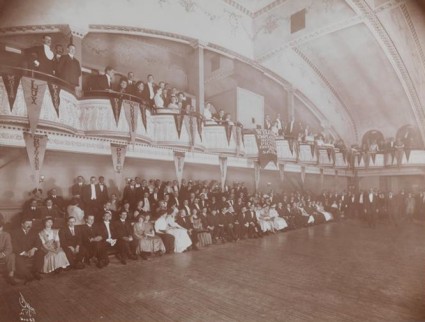A rare photograph showing the interior of a film business preview theatre, at the offices of American Cinephone Co., 124 East 25th Street, NYC, in 1910, from the MCNY Collections Portal
Now here’s an excellent resource for you. In 2010 the Museum of the City of New York launched its Collections Portal, opening up nearly 100,000 archival images of New York City to the web world. The collection is being added to all the time – a substantial collection of digitised postcards has just been added – and needless to say it offers plenty for the researcher interested in silent films.
The site is simple to use. The front page offers a striking browse option, where you can scroll laterally through images on the themes of Bridges, People, Waterfront, Skylines or Prints for Sale; or else by Borough (Bronx, Brooklyn, Manhattan etc.), or featured photographer. There is a simple search option, with the advanced search giving you the options of keyword, artist/maker, subject term, excluded subject term, or accession number. There is a lightbox facility for registered users. Each image has a title, description, original dimensions given, date, and is subject indexed under a variety of terms, encouraging further browsing as each term is hyperlinked to further search results (though note that, for example, ‘motion pictures’ as a linked term gets 81 hits, but ‘motion pictures’ simply typed into the search box gets 257 hits. Classification is helpful, but always selective). There is powerful zoom function, though paradoxically you have to squint to find it (look out for the mini magnifying glass bottom left of any image).
Interior of the Automatic Vaudeville theatre, 48 East 14th Street, NYC, c.1904. Mutoscope viewers can be seen on the right-hand side
There is plenty on film-related subjects, and a lot of them from the silent period. It is best to keep search terms simple, and using the terms ‘movie’, ‘film’ or ‘motion picture’ yield the best results (our traditional test term, ‘kinetoscope’, brings up four images). The emphasis is not so much on production as on the distribution, sales and exhibition side of things. So there are are some fascinating interiors of New York film businesses, including American Cinephone, Mutual, Empire Film Co., Pathescope and others, plus exteriors of cinemas and other venues – among the earliest film-related images is a set showing an amusement arcade from c.1904, the Automatic Vaudeville, which includes a line-up of peepshow Mutoscopes among its visitor attractions – a handy reminder that not all films of the period were experienced in cinemas. All in all one gets a picture of the early film business somewhat stripped of its glamour, but very much a part of the ebb and flow of the business life of a great city.
What should be especially interesting for researchers is to seek out film-related subjects which the MCNY people have not identified. Among the many street views and postcard images of early 20th century New York City, there are going to be those which show cinemas, nickelodeons, variety theatres which showed film, and so on, which may not be the main subject of the image. It’s an activity worth undertaking, as I know from having searched not unprofitably for similar images of early London film venues in postcards.
A motion picture industry employees’ ball, New York, c.1910. Among the companies whose pennants can be seen are Moving Picture World, Nicholas Power Co., Hog Reisinger, Thanhouser, Great Northern, Lux, Lumiere, Imp, Buffalo and Rex
If you do find anything new, you should tell the people at MCNY. Their website invites interested users to submit new information or corrections, and I can confirm that they reply promptly, and make amendments quickly.
Finally, although the site is partly aimed as the commercial market, with the lightbox and information on rights and reproduction fees, they also say that any image can be reproduced for non-commercial purposes on personal blogs, for research or other academic study. Good for them, and thank you.
Go explore.


